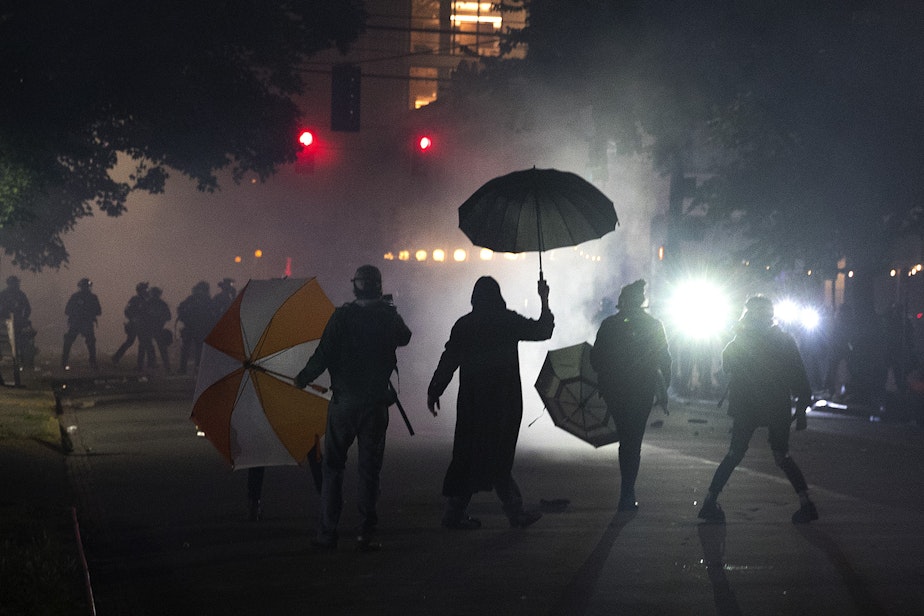Seattle protesters adopt 'Hong Kong' methods to avoid police intervention

All hell broke loose on Monday when someone popped open a magenta umbrella.
They held it over the metal barrier that divided Seattle police from thousands of protesters on Capitol Hill.
The tactic is reminiscent of an approach people in Hong Kong — protesting for increased democracy — used last year to shield themselves against mace.
In response, a Seattle Police officer grabbed the umbrella, and pulled it down, as another officer unleashed mace onto the crowd, multiple video accounts from Monday show.
Police launched flash bangs at the crowd. The crowd largely dispersed.
One person who attended the protest said it was surreal to see their city like that. They asked that KUOW not use their name, out of concern for their privacy.
Sponsored
“I was there completely peacefully, with everyone else there, with no bad intention, and we were being attacked by the people who were telling us they were trying to protect us,” they said.
Earlier in the day, things felt different. The large group with the magenta umbrella had marched peacefully on behalf of George Floyd, a Black man who died after a Minneapolis police officer kept his knee on Floyd’s neck.
It was the fourth day of ongoing protests in Seattle.
They chanted. They cheered. They called for onlookers to join in the movement — an uprising against police brutality toward Black people in the U.S. Some onlookers did.
Early in the evening, some Seattle Police officers kneeled with the crowd in a gesture of solidarity. A stark contrast to what erupted later.
Sponsored
People present at Monday night’s protest told KUOW that police tear-gassed the crowd. An MSNBC reporter, Jo Ling Kent, was nearly struck with a tear-gas canister while reporting live on the air.
One teenager, 17, was at home Monday, after marching with the crowd the day before. He watched online, through one of many livestreams.
On Sunday he was involved in peaceful marching around Capitol Hill. The organizers of the gathering, more or less, used Hong Kong tactics to keep the crowd together: Hand gestures to keep the crowd moving fast, and away from officers.
He described one moment, as the group traveled uphill, the police started biking toward them, coming up around protesters.
“Police to the right” was shouted out loud by someone, and soon others in the crowd repeated the phrase, causing the group to shift away from law enforcement.
Sponsored
The group stayed mobile, and outmaneuvered police, a tactic people in Hong Kong used, who adopted Bruce Lee’s mantra of “Be Water.”
On Monday, the teenager supported the movement in another way.
He was one of many who monitored police scanners, traffic cameras, social media, and local news remotely, and communicated what was happening to those on the ground.
“Often people in our group switch off, protesting one day and listening the next day,” he said.
The teen said some of the people who want to participate in the movement are in high school, and their parents won’t allow them to march. This was a way they could help.
Sponsored
“Everything police have done so far, to escalate the situation, makes everything worse,” he said. “I feel like they’re trying to put us in our place, but obviously no one is going to accept that.”
On Tuesday, Seattle Mayor Jenny Durkan stood with protest organizers and a large group of people who planned to march, near Pioneer Square.
“Your voices holding me accountable are important, and you should continue to raise them,” Durkan said. “We want you to march. We want you to raise your voices. We want you to continue on the path of justice, but we need you please to do it peacefully. And we know you can. We saw it yesterday.”
Shortly after, Durkan told the public during a press conference that the Office of Police Accountability and the Office of Inspector General would each independently review and investigate how Seattle Police handled events on Monday.
As the mayor was making these remarks, people — who had filled their bags full of water bottles, snacks, umbrellas, and goggles — settled into a fifth night of protesting for change.
Sponsored
An hour later, a daily curfew spanning through Friday evening was issued in Seattle.
On Tuesday night, protesters again lined up against barriers opposite Seattle police officers. Dozens at the front held umbrellas.
“Until the police get their act together and stop killing innocent Black people, and we refocus the police away from militarization and toward helping people, these protests are going to continue,” the teenager said.


